Bizarre Silks, Private Imaginings and Narrative Facts, etc.
An exhibition by Nick Mauss
07 Feb - 20 Sep 2020
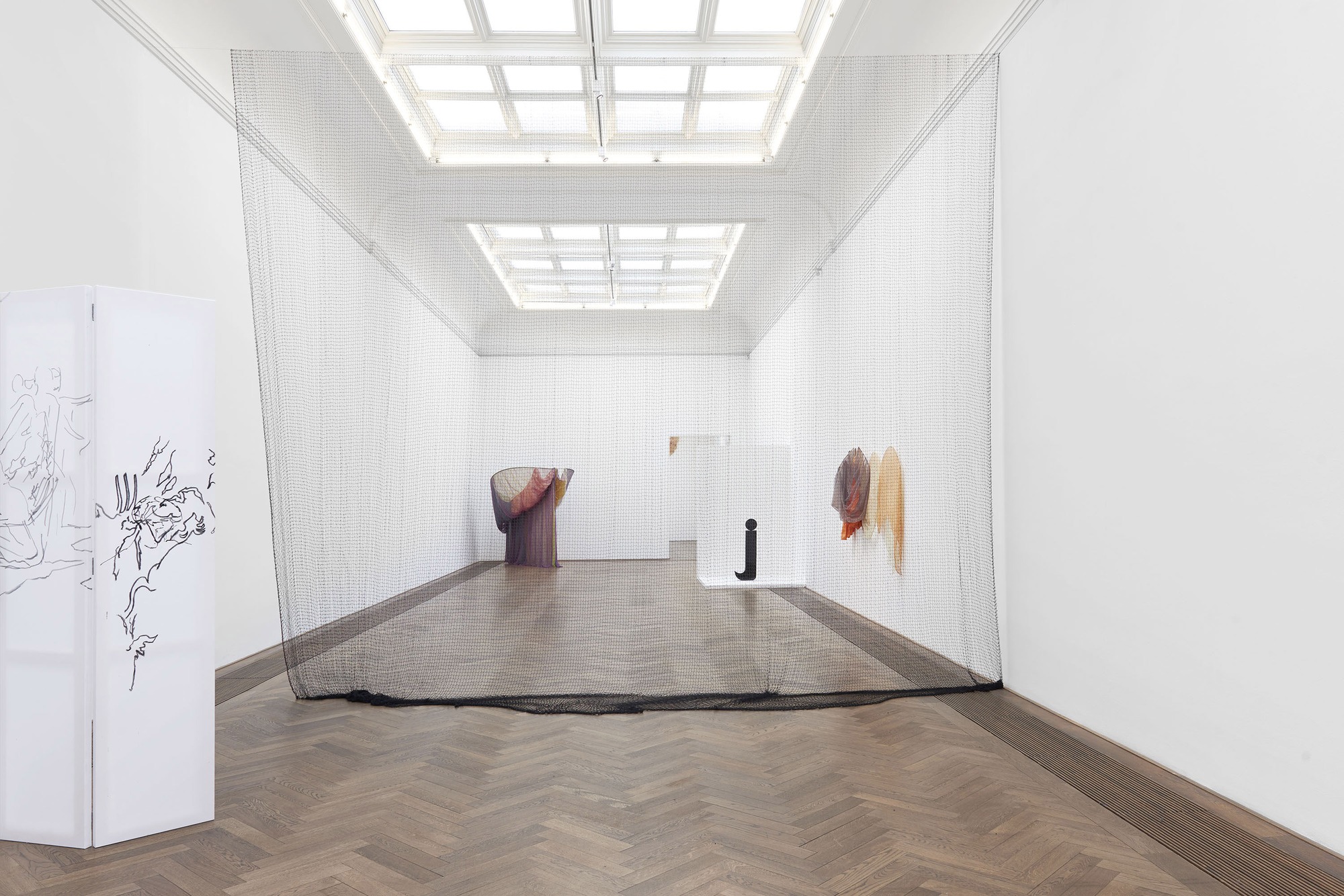
Installation view, "Bizarre Silks, Private Imaginings and Narrative Facts, etc.", an exhibition by Nick Mauss, Kunsthalle Basel, 2020. Photo: Philipp Hänger / Kunsthalle Basel
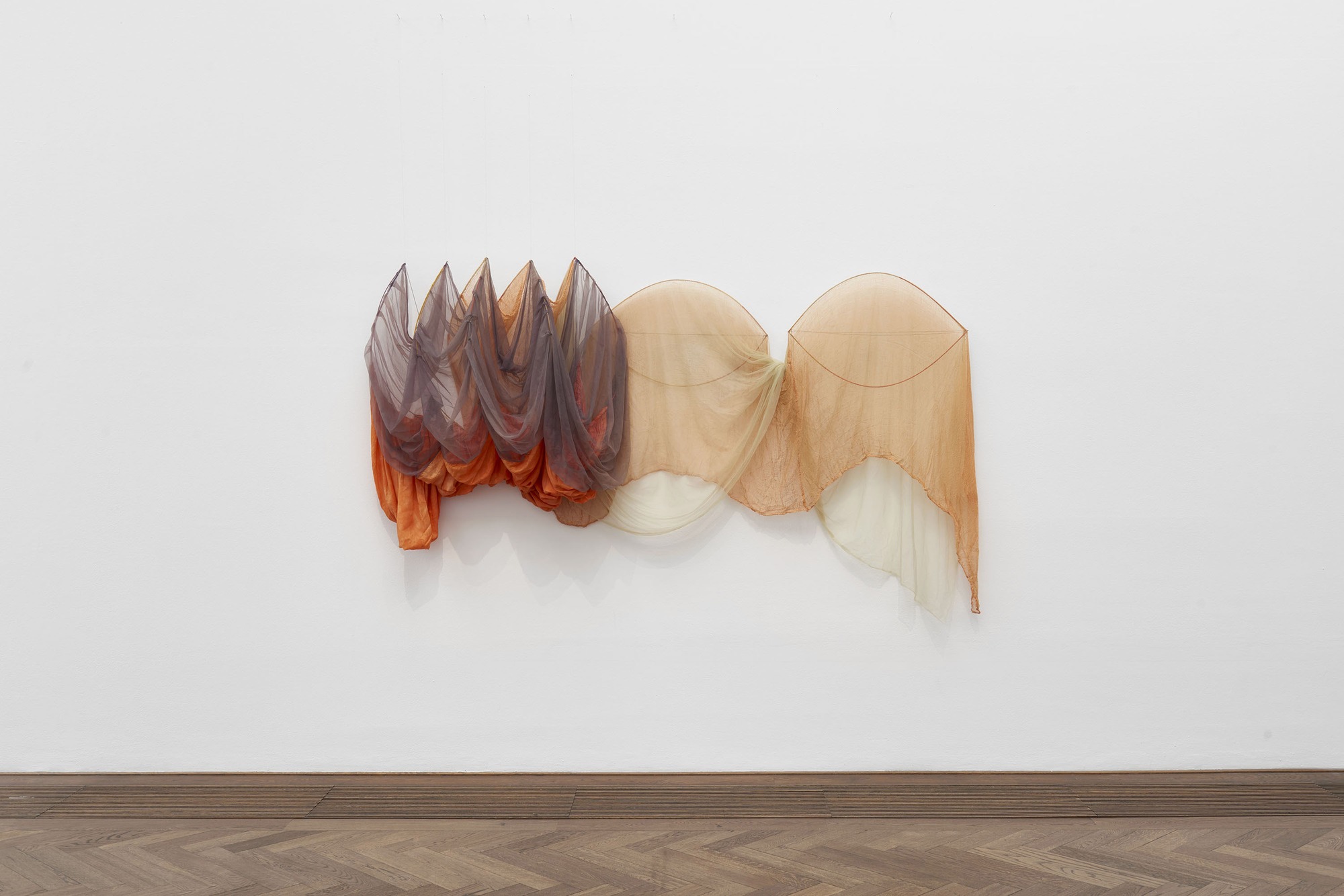
Installation view, "Bizarre Silks, Private Imaginings and Narrative Facts, etc.", an exhibition by Nick Mauss, view on Rosemary Mayer, "Hypsipyle", 1973, Kunsthalle Basel, 2020. Photo: Philipp Hänger / Kunsthalle Basel
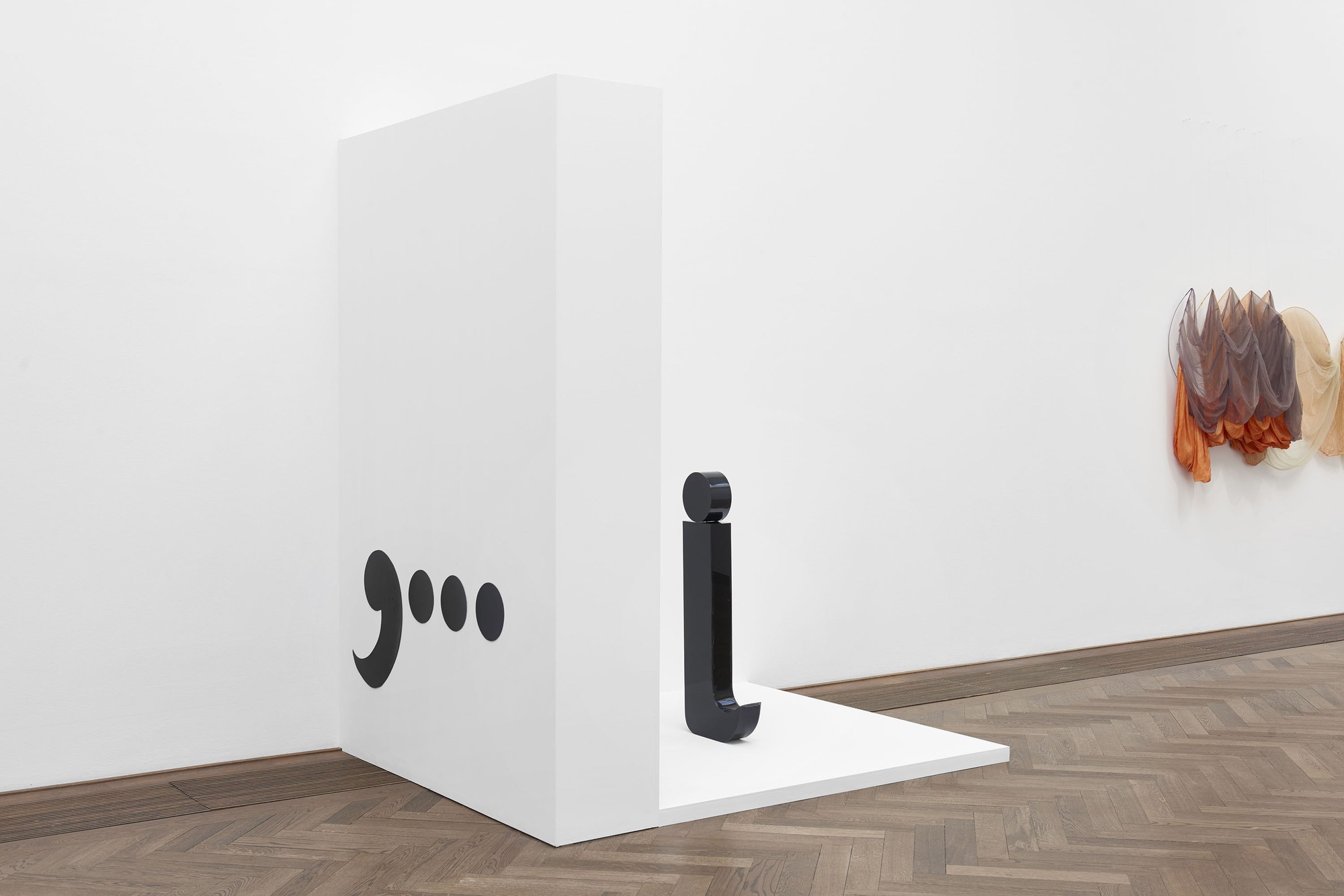
Installation view, "Bizarre Silks, Private Imaginings and Narrative Facts, etc.", an exhibition by Nick Mauss, view on (f.l.t.r.) Ketty La Rocca, "Comma with 3 dots", 1970; Ketty La Rocca, "J", 1970; Rosemary Mayer, "Hypsipyle", 1973, Kunsthalle Basel, 2020. Photo: Philipp Hänger / Kunsthalle Basel
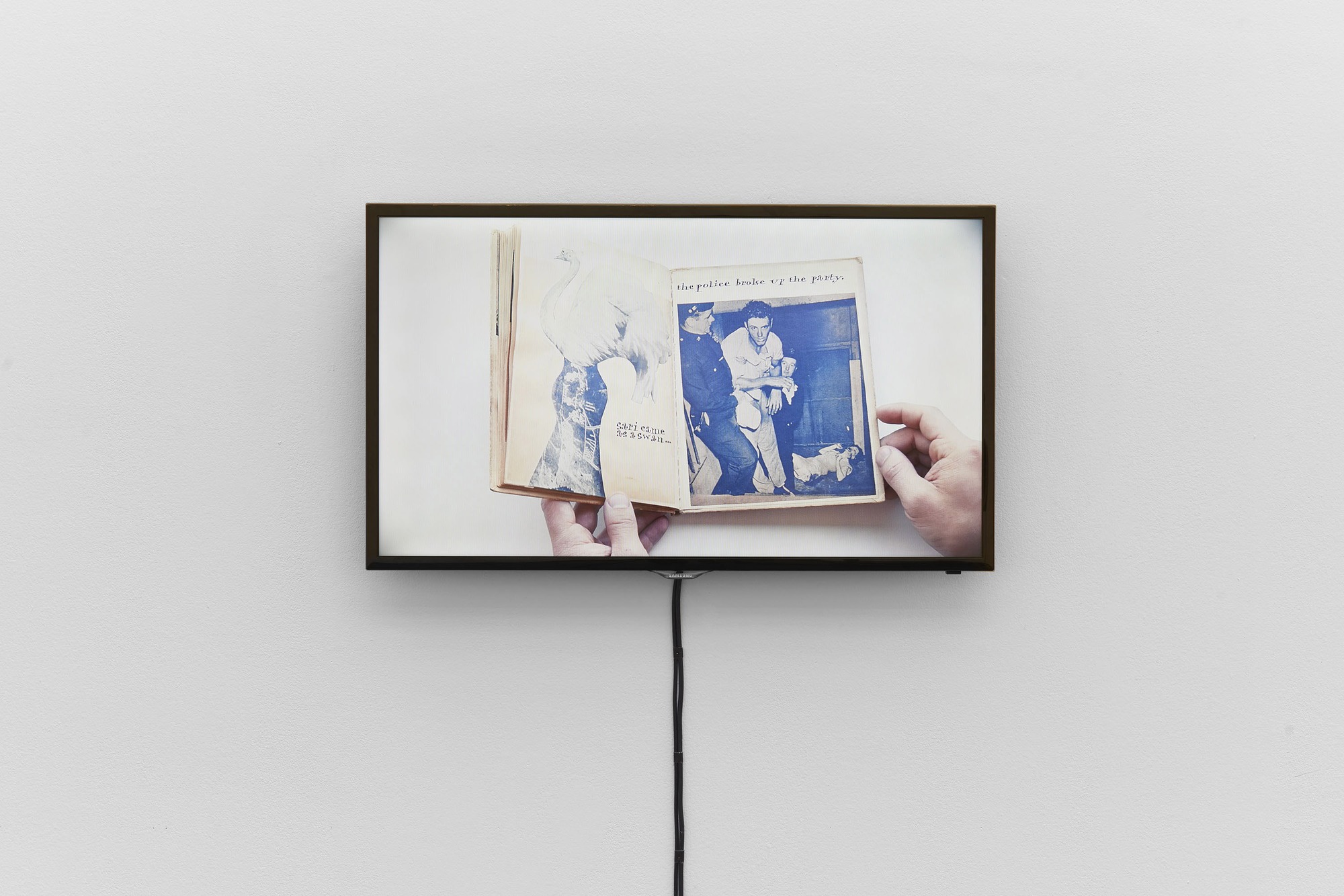
Installation view, "Bizarre Silks, Private Imaginings and Narrative Facts, etc.", an exhibition by Nick Mauss, view on video documentation of Ray Johnson’s artist book "Ray Gives a Party", ca. 1955, Kunsthalle Basel, 2020. Photo: Philipp Hänger / Kunsthalle Basel
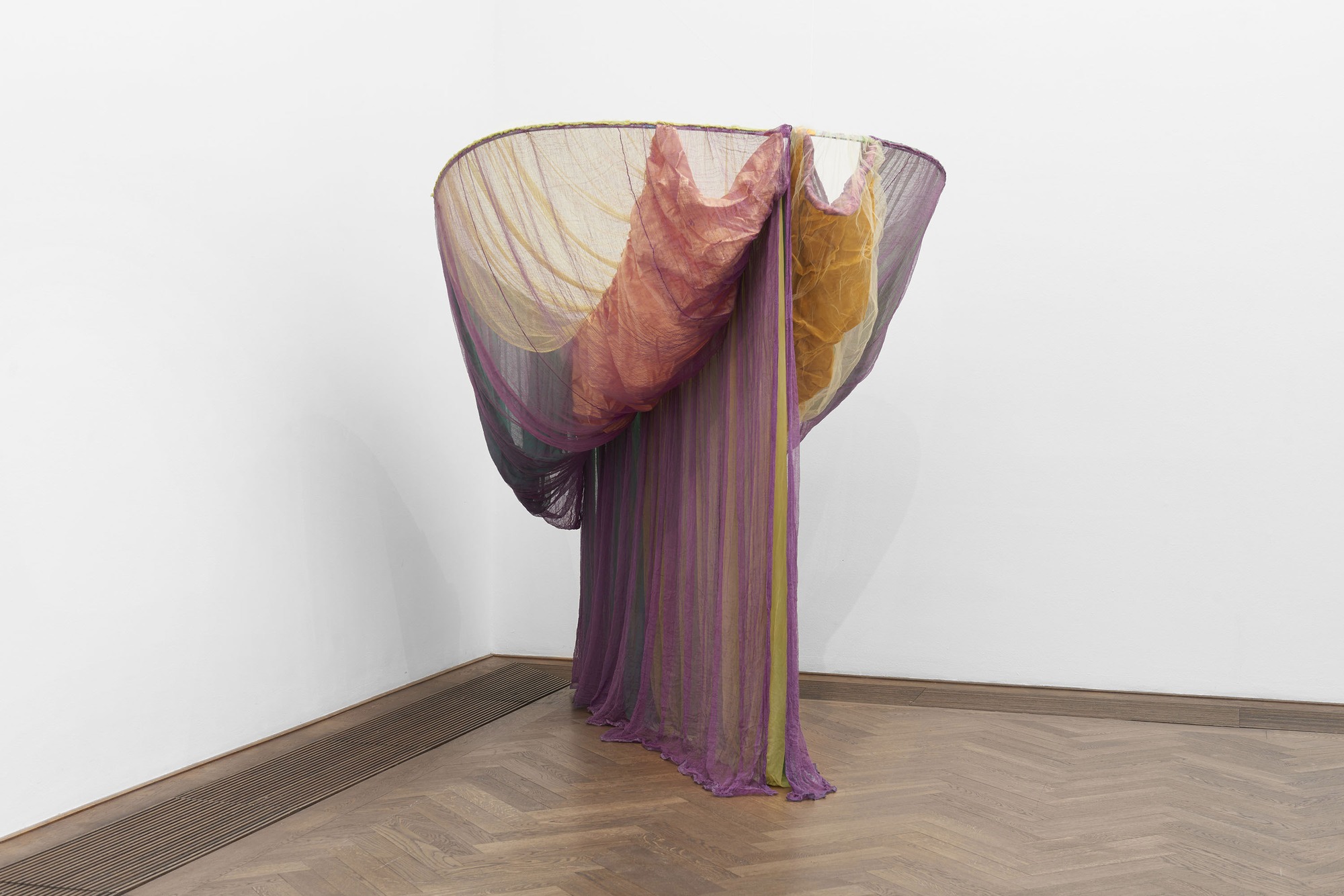
Installation view, "Bizarre Silks, Private Imaginings and Narrative Facts, etc.", an exhibition by Nick Mauss, view on Rosemary Mayer, "Galla Placidia", 1973, Kunsthalle Basel, 2020. Photo: Philipp Hänger / Kunsthalle Basel
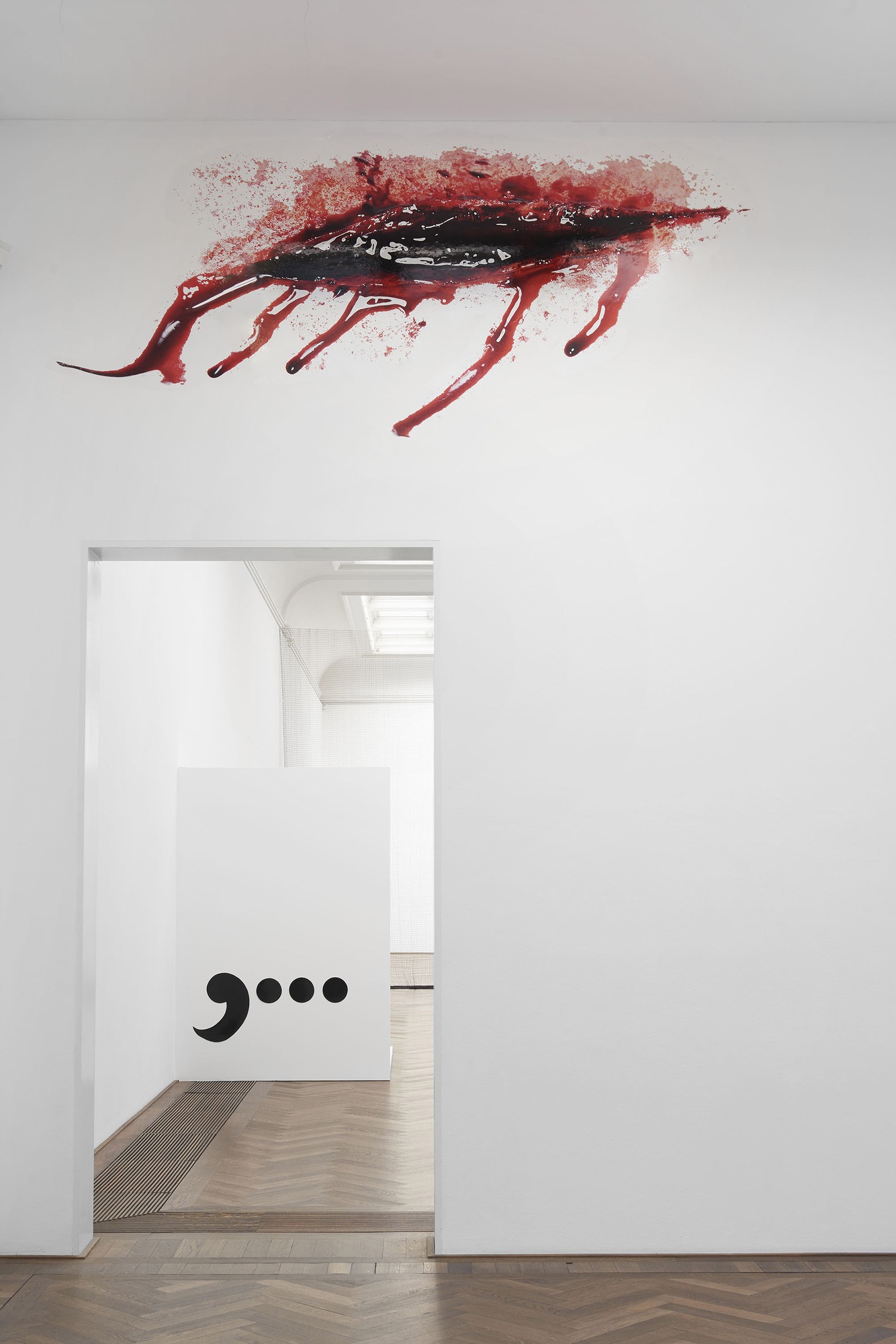
Installation view, "Bizarre Silks, Private Imaginings and Narrative Facts, etc.", an exhibition by Nick Mauss, view on (front) Georgia Sagri, "Deep Cut", 2018, and (back) Ketty La Rocca, "Comma with 3 dots", 1970, Kunsthalle Basel, 2020. Photo: Philipp Hänger / Kunsthalle Basel
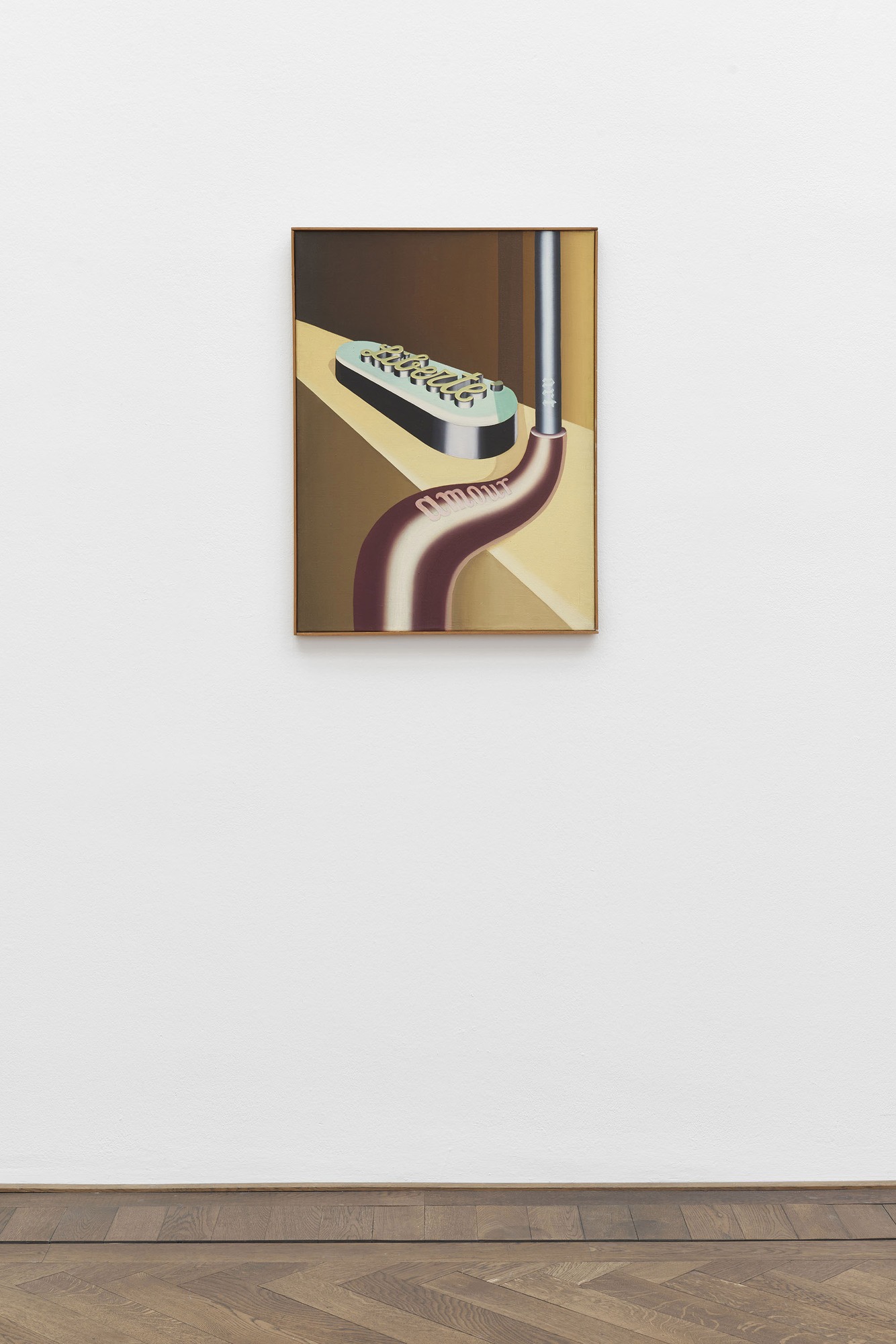
Installation view, "Bizarre Silks, Private Imaginings and Narrative Facts, etc.", an exhibition by Nick Mauss, view on Konrad Klapheck, "Liberté, amour, art", 1964, Kunsthalle Basel, 2020. Photo: Philipp Hänger / Kunsthalle Basel
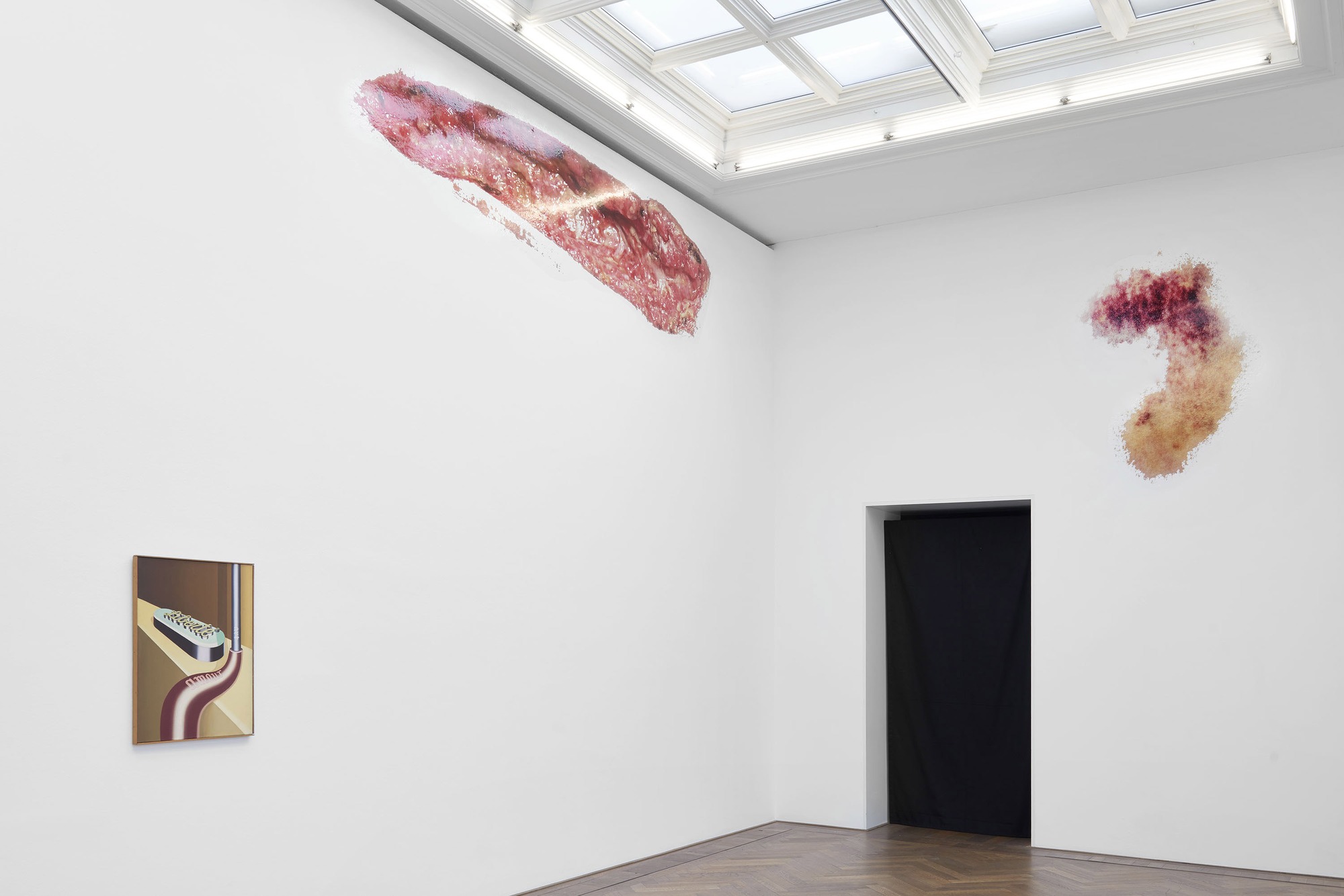
Installation view, "Bizarre Silks, Private Imaginings and Narrative Facts, etc.", an exhibition by Nick Mauss, view on (f.l.t.r.) Konrad Klapheck, "Liberté, amour, art", 1964; Georgia Sagri, "Open Wound", 2018; Georgia Sagri, "Fresh Bruise", 2018, Kunsthalle Basel, 2020. Photo: Philipp Hänger / Kunsthalle Basel
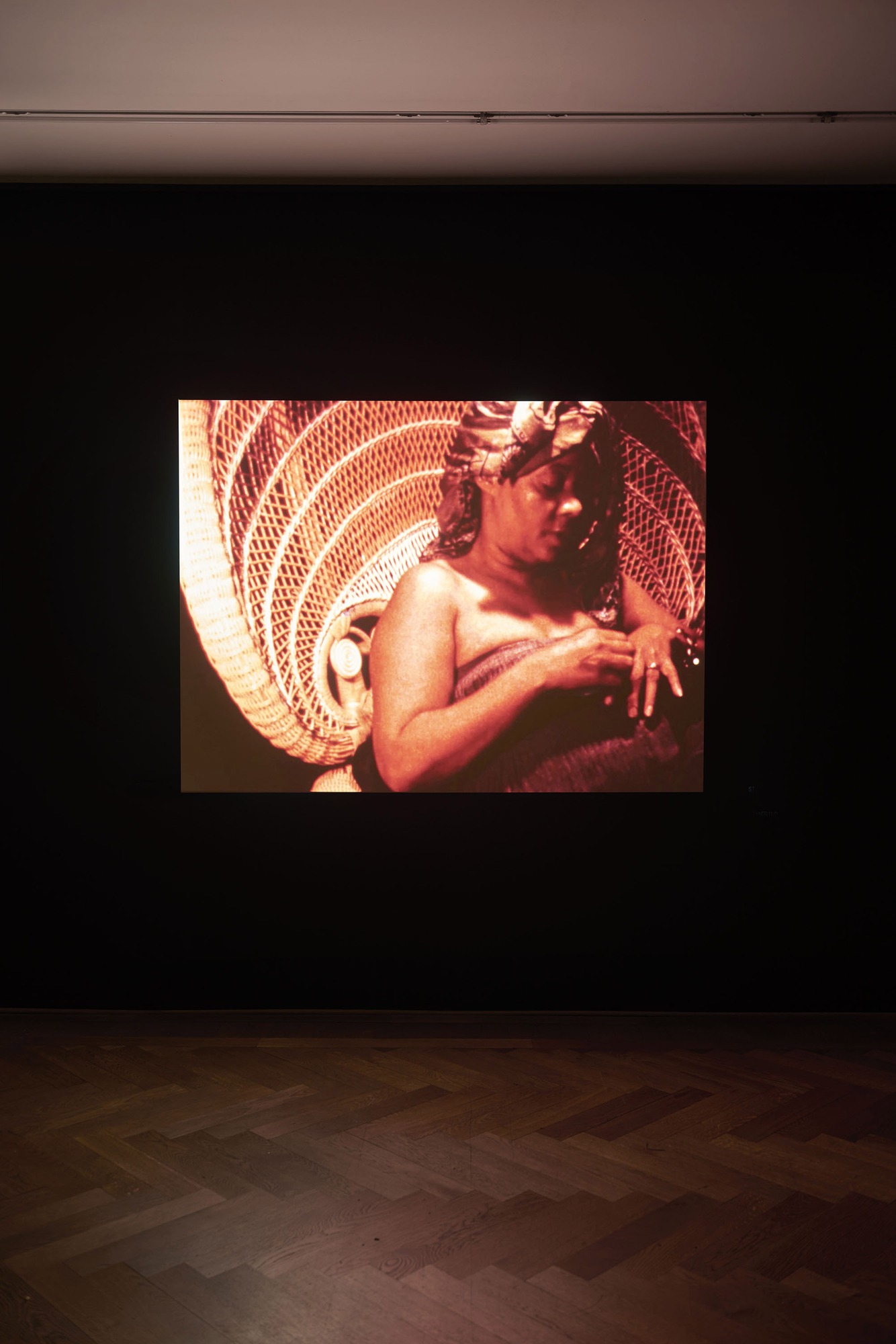
Installation view, "Bizarre Silks, Private Imaginings and Narrative Facts, etc.", an exhibition by Nick Mauss, view on Edward Owens, "Private Imaginings and Narrative Facts", 1968–70, Kunsthalle Basel, 2020. Photo: Philipp Hänger / Kunsthalle Basel
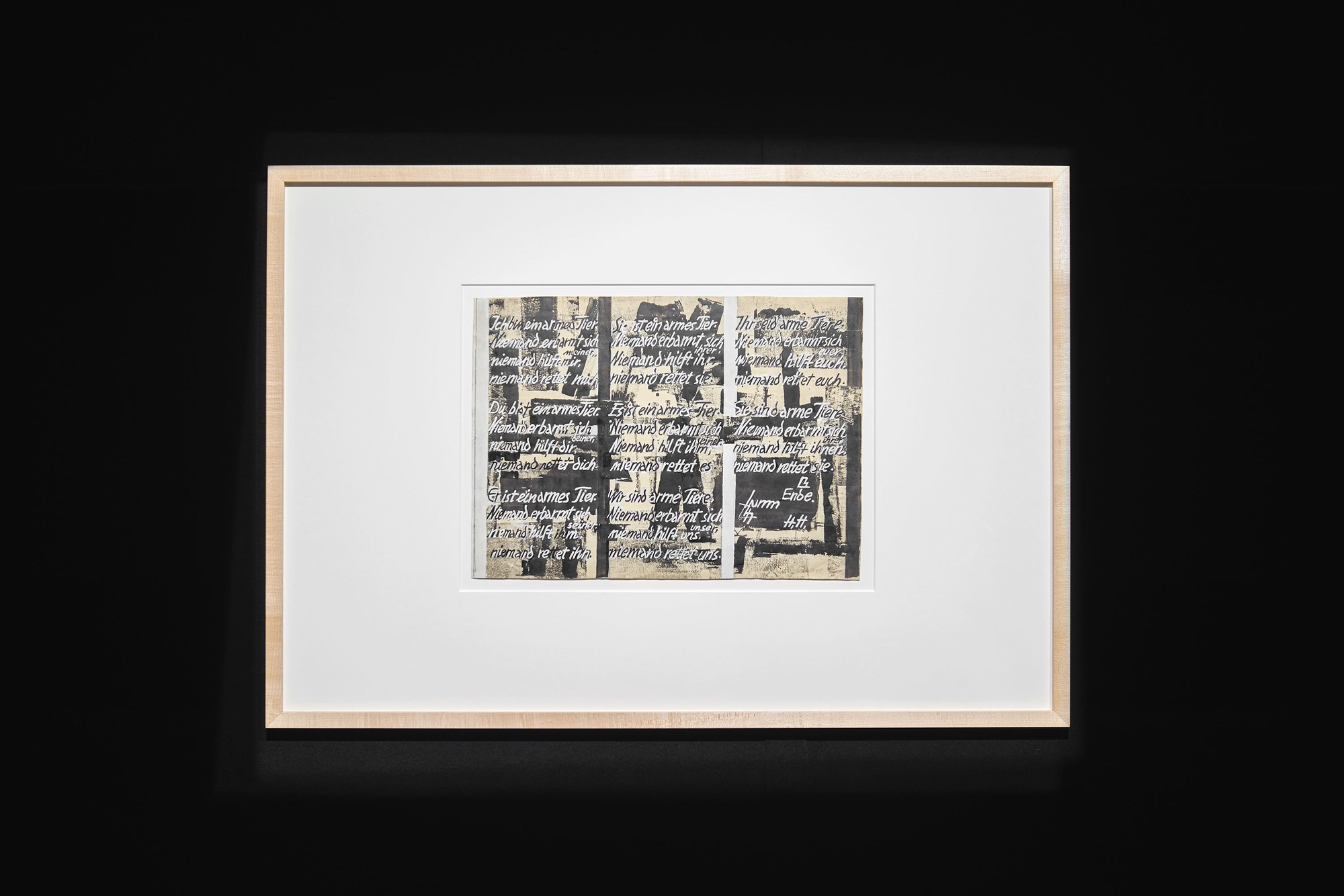
Installation view, "Bizarre Silks, Private Imaginings and Narrative Facts, etc.", an exhibition by Nick Mauss, view on Hannah Höch, "Ich bin ein armes Tier", 1959, Kunsthalle Basel, 2020. Photo: Philipp Hänger / Kunsthalle Basel
BIZARRE SILKS, PRIVATE IMAGININGS AND NARRATIVE FACTS, ETC.
An exhibition by Nick Mauss
7 February – 26 September 2020
Invited to stage an exhibition at Kunsthalle Basel, artist Nick Mauss has conceived "Bizarre Silks, Private Imaginings and Narrative Facts, etc." in which scenographic, conceptual, and curatorial concerns coincide. The act is in keeping with Mauss’s longstanding interest in the form of the exhibition as an artistic medium in its own right. "Bizarre Silks..." unfolds as a series of unexpected encounters in which the artist draws out each artwork’s distinct presence while heightening the relationships between them. Here, as in so many of his exhibitions, Mauss deliberately reacts to the conditions of a given space, paying attention to pacing and architecture, as well as creating devices for display, framing, and visual obstruction, which include a folding screen and a series of painted thresholds that reorient the viewer’s approach to what, and how, they are seeing.
How do you maintain a radical subjectivity?
Bea Schlingelhoff’s 2018 "Typeface dedicated to and named after Anne-Marie (Im Hof-) Piguet" in acknowledgment of the Swiss activist, addresses political consciousness as a means to surface a public memory.
Ray Johnson’s artist’s book "Ray Gives a Party" (ca. 1955) illustrates the pandemonium of costumed guests who attend an imagined party, including intimate and annoying friends, literary and artistic celebrities, and uninvited guests.
“Over centuries, there were Marie de France, Anna Comnena, Hroswitha, Christine de Pisane, Theophano, Eleanor of Aquitaine, Aethelflaed, Elizabeth of England, Elizabeth of Austria, Margaret of Austria, Margaret of Navarre, Margaret of Parma, Margaret of Valois, The Catherines: Catherine Sforza who fought the Medici, Catherine of Aragon who wouldn’t comply...” Rosemary Mayer’s litany of female potentates is a feminist evocation of forgotten names and of real lives distorted into myth. She pays homage through the works exhibited here to “all their colors, the texture of their garments, the hazy voluminous shapes they leave now hovering [...] Presence caught in thin veils, films of color on color.” Educated first as a classicist and later as an artist, Mayer was a founding member of A.I.R. Gallery, the first all-female cooperative gallery established in the United States in 1972. Over the course of her life she made works uneasily categorizable as either painting or sculpture, embracing drawing, writing, translation, temporary architectures, and events, all of which departed from the strict imperatives of minimalism and conceptual art.
"Galla Placidia" (1973) is named after the ancient Roman empress and shown here in confrontation with the sculptures of Ketty La Rocca.
La Rocca’s freestanding letter “J” (J, 1970) figures the French "je" (Eng. I) as a shiny, impermeable thing, while her "Comma with 3 dots" (1970) isolates the punctuation marks from any normative sound or “sense” to which they are meant to give structure.
Georgia Sagri’s oversized "Deep Cut, Open Wound", and "Fresh Bruise" (all 2018) transform the exhibition and the building that houses it into a vulnerable organism in a state of crisis to which the viewer is a witness and tasked with rethinking their conception of care.
Konrad Klapheck’s painting "Liberté, amour, art" (Eng. Freedom, love, art; 1964) departs from the artist’s monumental fetishized portrayals of industrial objects by depicting the titular words emblazoned on parts of an unspecified plumbing system. What might this say about the artist who has claimed, “by way of painting, I am involuntarily writing my autobiography. It’s not visible on the surface of a painting, it’s hidden underneath a layer of ice...”?
"Private Imaginings and Narrative Facts" (1968–70) is the work of Edward Owens—a precocious filmmaker whose career was cut short early on. He made all four of his surviving films when he was not yet twenty. Decades later, Jonas Mekas, in conversation with fellow filmmaker M.M. Serra, recalled Owens as “the first gay African American experimental filmmaker.” Ostensibly a portrait of Owens’ mother, Mildred, the film intercuts tender, lingering shots of a regal Mildred Owens with sudden glimpses of other subjects—an androgynous face, a Black Panther button, the dirty tip of a boot. Never arriving at a narrative, Owens’ miniature swirls fragments of aborted films and “real life” together with “fantasy” into a distillation of a lifetime’s yearnings.
A type of woven textile called “bizarre silks,” born out of the traffic in motifs kindled by the trade in textiles during the 17th and 18th centuries, constitutes a kind of ornamental feedback loop of industrial silk production and early global capitalism. These fabrics transport an erratic synthesis of various styles and origins: memories plucked from rococo, chinoiserie, the baroque, Persian quotations, and Japanese graphics collide to produce irrational flaming grotesques that anticipate, almost hallucinate, art nouveau. Hannah Höch’s postwar gouache "Ich bin ein armes Tier" (Eng. I am a poor animal,1959) at first looks like a child’s grammatical exercise. Conjugating a condition of being through every grammatical person, she transforms a feeling of utter abandonment into a statement of condemnation.
A 1986 work from Gretchen Bender’s series "TV Text and Image" (1986–1993) superimposes the statement “PEOPLE WITH AIDS” over a local TV channel broadcast. The harshness of the “message” fused to the surface of the TV “message” exaggerates a perverse dissonance between two irreconcilable (but simultaneous) planes of fact. Similarly, Megan Francis Sullivan’s paintings from the series "The Bathers (Inverted)" (2015–2017) render Paul Cézanne’s bathers at a confounding distance, flipping their color scheme, as if one were seeing them in negative. Inciting optical and conceptual reversals that are hard to hold in equilibrium, Sullivan’s doubled afterimages gain an additional charge here in proximity to Cézanne’s "Cinq baigneuses" (Eng. Five Bathers, 1885/1887) on view at the Kunstmuseum Basel, just down the street.
During his “decadent” phase of the 1980s, sculptor Robert Morris produced "Restless Sleepers/Atomic Shroud" (1981), a set of bed linens printed with text and images of atom bomb explosions and skeletons. A text can be found on each pillowcase that de- scribes the detonation of several nuclear bombs distributed over the globe “to achieve erasure.”
Ken Okiishi’s "Untitled" video from 2016 records a historically specific point of view: An unknown 21st century car’s approach into New York City as seen through the windshield. The banality of this episode quickly flips into surreality, resembling something photographer Eugène Atget (1857–1927) would have captured if he had had a smartphone, a car, and lived in New York City. Two untitled scrapbooks (1964–70, 1979) collaboratively made by William S. Burroughs and Brion Gysin are shown here as film, emphasizing their duration, tactility, and sequential illogic.
Victor Hugo Rojas (1942–93), a stylist of subversive luxury retail window displays and fashion designer Halston’s lover, was also a performance artist, captured here by artist Anton Perich in 1978 for his public access television show "Anton Perich Presents". Hugo’s performances were marked by ritual sacrifice– here Andy Warhol’s portrait of Hugo that is destroyed among heaps of plastic sheeting, gamboling kittens, clouds of baby powder, and attendants nodding to disco music.
Hugo’s performance shares a space with additional works by Mayer, “reenactments” of her no longer extant "Ghosts" (1981). Mayer’s art aspires to a meeting she termed “Object-as-Visitation.” Casting artwork and viewer in a symbolic confrontation, Mayer elicits a kind of stunned wonder through works that appear at once alien and ravishing.
The “miraculous encounter” finds an analog in “radical juxtaposition” throughout the exhibition, as it shuttles between text, texture, textility, transfiguration, and the fleshy reality of the body seen across works of decisively different epochs and genres. Constructing a temporary logic of proximities between specific artworks, gestures, and artifacts, "Bizarre Silks..." does not generate a cohesive synthesis, but allows them to exist in a voided present akin to the first time you see someone or something you are drawn to and you don’t know why.
On April 25, 2020, the New York-based artists Felix Bernstein and Gabe Rubin will perform at Kunsthalle Basel, using the entire exhibition as scenography. Their performance in Basel takes off from their ongoing analysis of madness and mimesis in drag and trans performance.
—Nick Mauss
An exhibition by Nick MaussWith works by:
Gretchen Bender, * 1951 in Seaford, US † 2004 in New York, US
Felix Bernstein and Gabe Rubin: both * 1992 in New York, US, both live and work in New York, US
William S. Burroughs and Brion Gysin: William S. Burroughs, * 1914 in St. Louis, US † 1997 in Lawrence, US
Brion Gysin, * 1916 in Taplow, UK † 1986 in Paris
Hannah Höch, * 1889 in Gotha, DE † 1978 in Berlin
Ray Johnson, * 1927 in Detroit, US † 1995 near Sag Harbor, US
Konrad Klapheck, * 1935 in Dusseldorf, DE lives and works in Dusseldorf
Ketty La Rocca, * 1938 in La Spezia, IT † 1976 in Florence, IT
Rosemary Mayer, * 1943 in Ridgewood, US † 2014 in New York, US
Nick Mauss, * 1980 in New York, US lives and works in New York
Robert Morris, * 1931 in Kansas City, US † 2018 in Kingston, US
Ken Okiishi, * 1978 in Ames, US, lives and works in New York, US
Edward Owens, * 1949 in Chicago US † 2009 in Chicago
Anton Perich, * 1945 in Dubrovnik, HR lives and works in New York, US
Georgia Sagri, * 1979 in Athens, lives and works in Athens and New York, US
Bea Schlingelhoff, * 1971 in Waiblingen, DE lives and works in Zurich, CH
Megan Francis Sullivan, * 1975 in Stamford, US lives and works in Berlin
and further anonymous works
An exhibition by Nick Mauss
7 February – 26 September 2020
Invited to stage an exhibition at Kunsthalle Basel, artist Nick Mauss has conceived "Bizarre Silks, Private Imaginings and Narrative Facts, etc." in which scenographic, conceptual, and curatorial concerns coincide. The act is in keeping with Mauss’s longstanding interest in the form of the exhibition as an artistic medium in its own right. "Bizarre Silks..." unfolds as a series of unexpected encounters in which the artist draws out each artwork’s distinct presence while heightening the relationships between them. Here, as in so many of his exhibitions, Mauss deliberately reacts to the conditions of a given space, paying attention to pacing and architecture, as well as creating devices for display, framing, and visual obstruction, which include a folding screen and a series of painted thresholds that reorient the viewer’s approach to what, and how, they are seeing.
How do you maintain a radical subjectivity?
Bea Schlingelhoff’s 2018 "Typeface dedicated to and named after Anne-Marie (Im Hof-) Piguet" in acknowledgment of the Swiss activist, addresses political consciousness as a means to surface a public memory.
Ray Johnson’s artist’s book "Ray Gives a Party" (ca. 1955) illustrates the pandemonium of costumed guests who attend an imagined party, including intimate and annoying friends, literary and artistic celebrities, and uninvited guests.
“Over centuries, there were Marie de France, Anna Comnena, Hroswitha, Christine de Pisane, Theophano, Eleanor of Aquitaine, Aethelflaed, Elizabeth of England, Elizabeth of Austria, Margaret of Austria, Margaret of Navarre, Margaret of Parma, Margaret of Valois, The Catherines: Catherine Sforza who fought the Medici, Catherine of Aragon who wouldn’t comply...” Rosemary Mayer’s litany of female potentates is a feminist evocation of forgotten names and of real lives distorted into myth. She pays homage through the works exhibited here to “all their colors, the texture of their garments, the hazy voluminous shapes they leave now hovering [...] Presence caught in thin veils, films of color on color.” Educated first as a classicist and later as an artist, Mayer was a founding member of A.I.R. Gallery, the first all-female cooperative gallery established in the United States in 1972. Over the course of her life she made works uneasily categorizable as either painting or sculpture, embracing drawing, writing, translation, temporary architectures, and events, all of which departed from the strict imperatives of minimalism and conceptual art.
"Galla Placidia" (1973) is named after the ancient Roman empress and shown here in confrontation with the sculptures of Ketty La Rocca.
La Rocca’s freestanding letter “J” (J, 1970) figures the French "je" (Eng. I) as a shiny, impermeable thing, while her "Comma with 3 dots" (1970) isolates the punctuation marks from any normative sound or “sense” to which they are meant to give structure.
Georgia Sagri’s oversized "Deep Cut, Open Wound", and "Fresh Bruise" (all 2018) transform the exhibition and the building that houses it into a vulnerable organism in a state of crisis to which the viewer is a witness and tasked with rethinking their conception of care.
Konrad Klapheck’s painting "Liberté, amour, art" (Eng. Freedom, love, art; 1964) departs from the artist’s monumental fetishized portrayals of industrial objects by depicting the titular words emblazoned on parts of an unspecified plumbing system. What might this say about the artist who has claimed, “by way of painting, I am involuntarily writing my autobiography. It’s not visible on the surface of a painting, it’s hidden underneath a layer of ice...”?
"Private Imaginings and Narrative Facts" (1968–70) is the work of Edward Owens—a precocious filmmaker whose career was cut short early on. He made all four of his surviving films when he was not yet twenty. Decades later, Jonas Mekas, in conversation with fellow filmmaker M.M. Serra, recalled Owens as “the first gay African American experimental filmmaker.” Ostensibly a portrait of Owens’ mother, Mildred, the film intercuts tender, lingering shots of a regal Mildred Owens with sudden glimpses of other subjects—an androgynous face, a Black Panther button, the dirty tip of a boot. Never arriving at a narrative, Owens’ miniature swirls fragments of aborted films and “real life” together with “fantasy” into a distillation of a lifetime’s yearnings.
A type of woven textile called “bizarre silks,” born out of the traffic in motifs kindled by the trade in textiles during the 17th and 18th centuries, constitutes a kind of ornamental feedback loop of industrial silk production and early global capitalism. These fabrics transport an erratic synthesis of various styles and origins: memories plucked from rococo, chinoiserie, the baroque, Persian quotations, and Japanese graphics collide to produce irrational flaming grotesques that anticipate, almost hallucinate, art nouveau. Hannah Höch’s postwar gouache "Ich bin ein armes Tier" (Eng. I am a poor animal,1959) at first looks like a child’s grammatical exercise. Conjugating a condition of being through every grammatical person, she transforms a feeling of utter abandonment into a statement of condemnation.
A 1986 work from Gretchen Bender’s series "TV Text and Image" (1986–1993) superimposes the statement “PEOPLE WITH AIDS” over a local TV channel broadcast. The harshness of the “message” fused to the surface of the TV “message” exaggerates a perverse dissonance between two irreconcilable (but simultaneous) planes of fact. Similarly, Megan Francis Sullivan’s paintings from the series "The Bathers (Inverted)" (2015–2017) render Paul Cézanne’s bathers at a confounding distance, flipping their color scheme, as if one were seeing them in negative. Inciting optical and conceptual reversals that are hard to hold in equilibrium, Sullivan’s doubled afterimages gain an additional charge here in proximity to Cézanne’s "Cinq baigneuses" (Eng. Five Bathers, 1885/1887) on view at the Kunstmuseum Basel, just down the street.
During his “decadent” phase of the 1980s, sculptor Robert Morris produced "Restless Sleepers/Atomic Shroud" (1981), a set of bed linens printed with text and images of atom bomb explosions and skeletons. A text can be found on each pillowcase that de- scribes the detonation of several nuclear bombs distributed over the globe “to achieve erasure.”
Ken Okiishi’s "Untitled" video from 2016 records a historically specific point of view: An unknown 21st century car’s approach into New York City as seen through the windshield. The banality of this episode quickly flips into surreality, resembling something photographer Eugène Atget (1857–1927) would have captured if he had had a smartphone, a car, and lived in New York City. Two untitled scrapbooks (1964–70, 1979) collaboratively made by William S. Burroughs and Brion Gysin are shown here as film, emphasizing their duration, tactility, and sequential illogic.
Victor Hugo Rojas (1942–93), a stylist of subversive luxury retail window displays and fashion designer Halston’s lover, was also a performance artist, captured here by artist Anton Perich in 1978 for his public access television show "Anton Perich Presents". Hugo’s performances were marked by ritual sacrifice– here Andy Warhol’s portrait of Hugo that is destroyed among heaps of plastic sheeting, gamboling kittens, clouds of baby powder, and attendants nodding to disco music.
Hugo’s performance shares a space with additional works by Mayer, “reenactments” of her no longer extant "Ghosts" (1981). Mayer’s art aspires to a meeting she termed “Object-as-Visitation.” Casting artwork and viewer in a symbolic confrontation, Mayer elicits a kind of stunned wonder through works that appear at once alien and ravishing.
The “miraculous encounter” finds an analog in “radical juxtaposition” throughout the exhibition, as it shuttles between text, texture, textility, transfiguration, and the fleshy reality of the body seen across works of decisively different epochs and genres. Constructing a temporary logic of proximities between specific artworks, gestures, and artifacts, "Bizarre Silks..." does not generate a cohesive synthesis, but allows them to exist in a voided present akin to the first time you see someone or something you are drawn to and you don’t know why.
On April 25, 2020, the New York-based artists Felix Bernstein and Gabe Rubin will perform at Kunsthalle Basel, using the entire exhibition as scenography. Their performance in Basel takes off from their ongoing analysis of madness and mimesis in drag and trans performance.
—Nick Mauss
An exhibition by Nick MaussWith works by:
Gretchen Bender, * 1951 in Seaford, US † 2004 in New York, US
Felix Bernstein and Gabe Rubin: both * 1992 in New York, US, both live and work in New York, US
William S. Burroughs and Brion Gysin: William S. Burroughs, * 1914 in St. Louis, US † 1997 in Lawrence, US
Brion Gysin, * 1916 in Taplow, UK † 1986 in Paris
Hannah Höch, * 1889 in Gotha, DE † 1978 in Berlin
Ray Johnson, * 1927 in Detroit, US † 1995 near Sag Harbor, US
Konrad Klapheck, * 1935 in Dusseldorf, DE lives and works in Dusseldorf
Ketty La Rocca, * 1938 in La Spezia, IT † 1976 in Florence, IT
Rosemary Mayer, * 1943 in Ridgewood, US † 2014 in New York, US
Nick Mauss, * 1980 in New York, US lives and works in New York
Robert Morris, * 1931 in Kansas City, US † 2018 in Kingston, US
Ken Okiishi, * 1978 in Ames, US, lives and works in New York, US
Edward Owens, * 1949 in Chicago US † 2009 in Chicago
Anton Perich, * 1945 in Dubrovnik, HR lives and works in New York, US
Georgia Sagri, * 1979 in Athens, lives and works in Athens and New York, US
Bea Schlingelhoff, * 1971 in Waiblingen, DE lives and works in Zurich, CH
Megan Francis Sullivan, * 1975 in Stamford, US lives and works in Berlin
and further anonymous works
